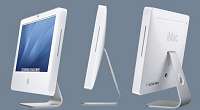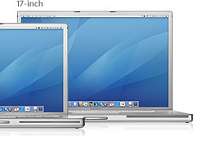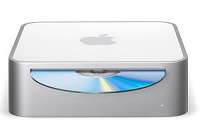- By Richard Meagher
- Business & Technology
 Print
Print There are really two kinds of computers you can buy today, machines that run (sometimes) on the nearly ubiquitous Microsoft Windows operating system sold at many retailers and used by over 80% of computer users around the world and the iMac. The iMac, while not a dominant market player in the personal computer market, is designed, manufactured and sold by the same the company that makes its fortune from selling the popular portable music player, the iPod. That company is Apple.
The smaller market share that the iMacs make up is actually an advantage when it comes to security. iMacs are virtually immune to malicious viruses and spyware that are often cloaked in otherwise innocent looking files or e-mail attachments when downloaded from the Internet. That’s because many of these malevolent bits of data are designed to infiltrate Windows systems whose swiss-cheese security features continue to be challenged daily by new attacks. Hackers are more likely to be motivated into trashing Windows machines than iMacs because most iMac users are educators and graphic design houses, not the large financial institutions, banks and government offices that could be significantly impacted by a simple virus.
So, why should seniors buy iMacs? For one, its simple, yet elegant, design makes it easy to take out of the box, put on a small table or desk and plug it in. The newer iMacs are all built into a single one-piece case including the flatscreen monitor. If you opt for a wireless keyboard and mouse, then you have only two cables to connect, one for power and one for the Internet. If you have a wireless network, dump the Internet cable and all you need is the power cord! Within a matter of minutes, the machine will be up and running and asking you questions so that it can configure itself to connect to the Internet. Many seniors who have downsized their living quarters from a two story single family home to an apartment sized condominium will appreciate the small space required to set-up and use an iMac. No bulky CPU box or oversized CRT monitors that can consume your entire writing desk. With an iMac, it will take up no more space than a few of your favorite cookbooks or novels with bookends.
The new iMacs not only are great for websurfing and chatting with your friends online, they also come with a built-in video camera so your friends and loved ones can see you in living color while you chat. Careful, you don’t want to leave your bedroom without your robe or your hair uncombed. Besides websurfing and chatting, the iMac comes with a lot of software that you can use for downloading and listening to music (iTunes), downloading TV programs and watching your favorite DVD movie. You can even load pictures and movies from digital cameras to edit and record on DVD with the music you have downloaded from iTune. Some iMac models come with a remote control so you can sit back and watch your own productions or your favorite Seinfeld reruns having to use your keyboard and mouse. If you enjoy music and making your own, GarageBand is another cool addition that allows you to compose your own melody and even play it back on your iPod.
That’s the other thing I wanted to mention, is that if you have an iPod, especially the latest ones with color and video playback, you can transfer your movies, photos and songs to take with you and show your friends from you iMac. Leave the purse and the bulky photo album at home, the iPods can hold several hundred pictures. What better way to watch family movies, downloaded TV programs and listen to your favorite tunes while you travel or visit family and friends?
Now you are wondering about price. Well, I will tell you; with an iMac you will get what you pay for and then some. Don’t try to compare a $1300 iMac desktop with a $600 Dell system. It doesn’t work that way. Feature for feature, compared to the lowest priced iMac at $1300, the Dell system is actually closer to $1200 and even more when you consider that the iMac has a built-in video, something that you have to add with more cables to the Dell.
One thing to remember is that Dell, as good as they are with their excellent reputation for customer service, is a mass-market producer of a confusing array of systems to choose from, while Apple is a niche player with a simple line of award winning systems that won’t cramp your space or style.
Like many Windows PCs, Apple makes both desktop and portables in different configurations, but they are easy to choose from. For seniors, I recommend the following models:
 Desktop - G5 with 17” or 20” screen size. If you like to use the iMac as your home entertainment system so you can watch movies, go for the 20” if your budget allows. These models sell for $1299 and $1699. Either way, the flat screen monitors are very sharp and crisp. Both are wireless networking ready. Desktop - G5 with 17” or 20” screen size. If you like to use the iMac as your home entertainment system so you can watch movies, go for the 20” if your budget allows. These models sell for $1299 and $1699. Either way, the flat screen monitors are very sharp and crisp. Both are wireless networking ready. |
 Portable – iBook with 12” and 14” screen sizes. The smaller 12” model can fit in a large purse or backpack and is a big hit with folks who are very mobile but don’t like the bulky excess weight to carry around. These models sell for $999 and $1299. There are more powerful Powerbook models that sell for $1499 and up if you want a lot of speed and power. These machines come with built-in wireless networking so you can log in to the Internet at a wireless access point like Borders Café, Barnes and Noble and select locations in Ithaca. You may need to purchase service for a fee. Portable – iBook with 12” and 14” screen sizes. The smaller 12” model can fit in a large purse or backpack and is a big hit with folks who are very mobile but don’t like the bulky excess weight to carry around. These models sell for $999 and $1299. There are more powerful Powerbook models that sell for $1499 and up if you want a lot of speed and power. These machines come with built-in wireless networking so you can log in to the Internet at a wireless access point like Borders Café, Barnes and Noble and select locations in Ithaca. You may need to purchase service for a fee. |
 Want a Mac but don’t want to give up your PC? – A third choice is to buy an iMac mini a tiny machine that has no monitor, keyboard or mouse. Yet, it packs a lot of power into its small size and it is not much bigger than 6 CD Jewel cases stacked together. You can use your existing PC monitor, keyboard and mouse, so it can be a great way to start out with iMacs. Three different models starting at $499 are available Want a Mac but don’t want to give up your PC? – A third choice is to buy an iMac mini a tiny machine that has no monitor, keyboard or mouse. Yet, it packs a lot of power into its small size and it is not much bigger than 6 CD Jewel cases stacked together. You can use your existing PC monitor, keyboard and mouse, so it can be a great way to start out with iMacs. Three different models starting at $499 are available |
NOTE – iPods are extra and not included!
Where to buy
Like Dell, Apple sells most of its computers through its own website (http://www.Apple.com) but unlike Dell, it also has boutique shops found in many malls across the country. It also sells through other retailers like CompUsa and websites like MacZone and CDW.com. The closest Apple store is in Syracuse at the Carousel Mall, which is also where Compusa can be found.
If you are a teacher, you qualify for academic discounts, which can save you $100.00 or more. Cornell faculty and students can purchase iMacs at the Technology Connection or from the Apple Education Website, which lists Cornell and Ithaca College among participating institutions including several area public and private K-12 schools.
----
v1i22




